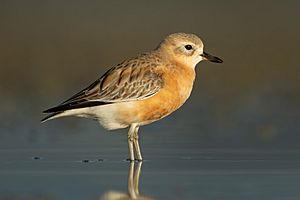New Zealand dotterel facts for kids
Quick facts for kids New Zealand dotterel |
|
|---|---|
 |
|
| Conservation status | |
| Scientific classification |
The New Zealand dotterel (Charadrius obscurus) is a special type of shorebird. You can only find it in certain parts of New Zealand. People also call it the New Zealand plover or red-breasted dotterel. Its Māori names include tūturiwhatu, pukunui, and kūkuruatu.
One type of New Zealand dotterel, found in the south, was almost gone. In 1990, there were only about 75 of them left. But thanks to special efforts, their numbers grew to 250 by 2005.
Contents
About the New Zealand Dotterel
A scientist named Johann Friedrich Gmelin first described this bird in 1789. This was in his book called Systema Naturae.
In 2015, a study showed that the New Zealand dotterel's closest relatives are two other New Zealand plovers. These are the wrybill and the double-banded plover.
Different Types of Dotterels
Scientists recognize two main types, or subspecies, of the New Zealand dotterel. Some even think they should be seen as completely separate species. This idea is supported by the Handbook of the Birds of the World and the IUCN.
- C. o. aquilonius - This type lives on the North Island of New Zealand.
- C. o. obscurus - This type lives on the South Island and Stewart Island (also called Rakiura).
Where Dotterels Live
New Zealand dotterels usually live in two separate areas of New Zealand. They often prefer sandy beaches and sand spits. You can also find them looking for food in tidal estuaries, which are places where rivers meet the sea.
The northern group lives on the North Island. The southern group lives at the bottom of the South Island and on Stewart Island/Rakiura.
Life Cycle and Reproduction
New Zealand dotterels lay their eggs during spring and summer. They make their nests on beaches, above where the high tide reaches. Their nest is just a shallow hole dug in the sand. It's not made of twigs like a bird's nest in a tree.
The chicks hatch about 28 days after the eggs are laid. Because their nests are on the ground, the chicks can walk on the very first day they hatch! The parents do not feed the chicks. The young birds have to find their own food. They can usually fly when they are about 6 to 8 weeks old.
Protecting the Dotterels
The IUCN looks at the two types of dotterels as separate species. They say the northern type is "Near Threatened". This means it could become endangered soon. The southern type is "Critically Endangered". This means it is at very high risk of disappearing forever.
In 1990, there were only about 62 southern dotterels left. Studies from 1988 to 1992 showed their numbers were dropping fast. To help them, people started conservation efforts. This included controlling feral cats, which can hunt the birds. Because of these efforts, the number of southern dotterels slowly grew. About 250 birds were counted in 2005.
The northern type of dotterel lives in a larger area. In 1989, there were about 1300 of them. By 2004, their population had grown to about 1700 birds. But this growth happened only because of a lot of hard work to protect them.
In the Wellington Region, the northern dotterel is considered "Regionally Critical."
Gallery
See also
 In Spanish: Chorlito maorí para niños
In Spanish: Chorlito maorí para niños






